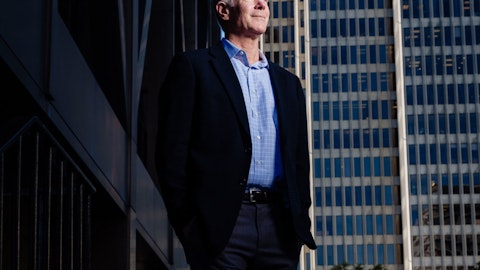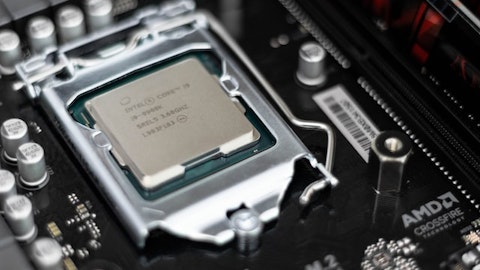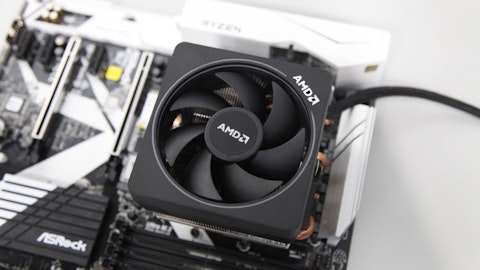We feel very good about that, and we’re excited about supporting them further in the future. But the Android opportunity as a whole is something that I think for us is not as large when we look further out, as the potential of the laptop opportunity. So we can see, as we look a few years out, we can see a scenario where the laptop opportunity in our laptop business exceeds that of our Android business. And that’s one where we have, I think, much more greenfield space for expanding content and gaining market share right now. So that’s the greater area of our focus when it comes to customer engagement and new product development.
Operator: Your next question comes from the line of Tore Svanberg. Tore, your line is now open.
Tore Svanberg : Yes. Thank you. And congrats on the results, especially getting through this wafer purchase commitment in light of the spread product that was great execution on your side. I had a question about the 22-nanometer products John, you mentioned the word introducing them next year. So does that mean that they will be sampling in calendar ’24, and then we’ll see potential revenues the year after?
John Forsyth: They are sampling today. Thank you for opening the door to that clarification. Sorry, they’re sampling today. The 22-nanometer smart codec in particular, is the product that we’re talking about. That’s in our customers’ hands. It’s performing beautifully. It’s a marvelous product, and we’re very happy with it, which means that we are working towards a market introduction in the back half of next calendar year.
Tore Svanberg: Very good. And as far as the timing and opportunity in laptop, I understand you’re in the top 5 today. But as far as this sort of bigger content ramp. Is that something that could happen already next year? Or is that more a calendar ’25 or ’26 story?
John Forsyth: Yes, that’s a great question. Obviously, I’ve referred to the fact that we have a significant number of designs in development now. And we need that, but it’s also important to have the right being the right products, have the right designs in development and enough of them to start moving the needle on revenue given where our overall revenue is today. So I guess I’ll try to frame that for you in broad terms so you can get a sense of what we anticipate could happen here. This year, as I mentioned, we’ve got a number of designs coming to market within the remainder of fiscal ’24, including the poster child device that I referred to in my prepared remarks, which we’re very proud about. But by definition, anything shipping in the second half of the fiscal year, and that really means in practice in the laptop space, most likely in the early part of next calendar year isn’t going to contribute much during the current fiscal year.
So think of the contribution of laptops in our fiscal ’24 as being pretty minimal. However, those — there are designs coming to market now, which will start to contribute to revenue as we move into fiscal ’25. So we anticipate seeing a moderate step-up in fiscal ’25 as more of those current design wins not going into production, putting us likely in the range of the low tens of millions of revenue in fiscal ’25. A lot of what’s happening today around the reference platforms that I mentioned in the prepared remarks, will lead to customer product that’s launching early calendar ’25. So we would anticipate that, that would likely lead to steeper growth and more meaningful revenue than in fiscal ’26 and beyond. And as I mentioned, previously, I know that we don’t break it out as such, but to give you a sense of how we think about the opportunity.
If Android stayed flat, then somewhere beyond that, we are — we see the potential for our laptop revenues to overtake the Android business.
Operator: [Operator Instructions] Your next question comes from the line of Blayne Curtis. Blayne, your line is now open.
Blayne Curtis : Hey, thanks for taking my question. I wanted to ask you, you’ve been mentioning several quarters in a row diversification efforts in HPMS. I don’t read too much in the language, but I guess the language is a little different. You said there’s some customer interest in power and battery. Can you just talk about the diversification efforts and maybe any kind of rough timing as to when we should think about maybe that impacting the model?
John Forsyth: Yes, we certainly have customer interest, Blayne, and principally, that’s around the power space. So really stuff that sits around the battery is an area that we believe we have significantly differentiated technology. We have that IP in silicon for the most part at this point. So we’ve been able to demonstrate IP to customers there, and we’re excited about tha. Translating that into specific program design awards and design wins and so on. I’m going to limit what I say on this call, but that would be a little further out. That’s obviously beyond the audio products that we’ve got coming next year. It’s likely still some time before we see that come to fruition, but we believe there are meaningful opportunities. So we’re certainly investing in securing those.
Blayne Curtis: Thanks. And then maybe a question for Venk. I wanted to ask on seasonality for March. Obviously, the 14 weeks impacts OpEx, I don’t know with such high customer concentration, whether that matters for revenue. But any thoughts on March seasonality.
Venkatesh Nathamuni: Yes. I mean it’s too early to talk about March. But you’re right. I mean in terms of just the current December quarter, we do have that extra week of both revenue and expenses, and that’s kind of factored into the guidance. Now what happens in March, obviously, is a big function of what happens to our — the top customers’ main product. So I think we’ll just reserve judgment on it. But a typical sequence between the December quarter and March quarter is that there’s a seasonal decline. We’ll quantify it at the right time. But I don’t see anything that’s different this time around in terms of the seasonality, just the magnitude of it is what we’ll have to determine going forward.
Chelsea Heffernan : And this will be our last question.
Operator: Our last question comes from the line of Ananda Baruah. Ananda, your line is now open.
Ananda Baruah : Hey, thanks guys. I appreciate the questions. I guess going back to the PCs, John, would you — if the sort of it’s thought that there perhaps could be a little bit of a PC adoption dynamic in 2024. If that were to happen broadly would you anticipate seeing an impact to your PC business that we may notice as well? And then I have a quick follow-up also.
John Forsyth: Sorry, are you referring to headwinds in the PC market?
Ananda Baruah: Tailwinds in the PC market. A bit of a PC cycle. Yes.
John Forsyth: I guess, yes, although we’re still building design momentum. So we would certainly expect to benefit from that. And we think that when you do an AB comparison between laptops that have Cirrus Logic audio and haptics in them versus competitive products that do not. The difference is really striking. It’s really a night and day difference. We’re very, very proud of what we’re doing there, and we think it’s really meaningful for the PC experience. So I would certainly hope to benefit from that next year, even if we’re still building our design momentum in our pipeline today.



